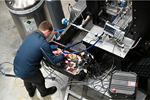Swinburne, Sparc Technologies researchers to create graphene-enabled smart composites
Connected smart structures are being built that can be wirelessly monitored in real time for hard-to-detect defects, enabling safer, more reliable and cheaper air and space travel.
Graphene-enhanced smart composite material. Photo Credit: Swinburne University of Technology
New industry-linked research between (Melbourne, Australia), (Kent Town, South Australia) and Composite Materials Engineering is creating a new generation of smart composites that could help engineers detect structural defects in planes and rockets before they happen, while also reducing costs in the energy, transport and aerospace sectors.
Realized through university and industry collaboration, the ARC Linkage-funded project aims to use graphene-based nanomaterials to create a working prototype of a smart carbon fiber structure with wireless connectivity that can be remotely monitored for difficult-to-identify defects in real time. This includes enabling technicians to monitor wind turbine blades in remote mountain or coastal locations and detecting faults in airplane and rocket parts before they fail.
Deputy vice-chancellor research, Professor Karen Hapgood, says the project used Swinburne’s capabilities and expertise in space, aerospace and advanced manufacturing to make a real-world impact. “Smart composites, such as those being created by this project, represent the connected future of our cities, our structures and our networks,” Hapgood says.
Lead investigator and associate professor Nishar Hameed adds that the project will have important implications for safety, reliability and cost in space, aerospace and renewable energy. “This technology could help address the cost — human, economic, environmental — of catastrophic disasters like airplane crashes, while delivering benefits across a range of industries.”
Related Content
-
Bladder-assisted compression molding derivative produces complex, autoclave-quality automotive parts
HP Composites’ AirPower technology enables high-rate CFRP roof production with 50% energy savings for the Maserati MC20.
-
Low-cost, efficient CFRP anisogrid lattice structures
CIRA uses patented parallel winding, dry fiber, silicone tooling and resin infusion to cut labor for lightweight, heavily loaded space applications.
-
Otto Aviation launches Phantom 3500 business jet with all-composite airframe from Leonardo
Promising 60% less fuel burn and 90% less emissions using SAF, the super-laminar flow design with windowless fuselage will be built using RTM in Florida facility with certification slated for 2030.



